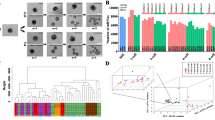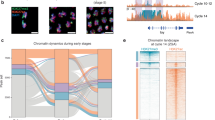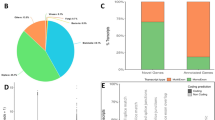Abstract
Rare minnow (Gobiocypris rarus), a model organism with a transparent chorion and sensitivity to chemicals, is widely used in toxicology and developmental biology. This study provides high-quality gene expression profiles of rare minnow embryos at three key developmental stages: blastula, gastrula, and optic rudiment, obtained via next-generation sequencing (NGS). The dataset is essential for studying zygotic genome activation (ZGA) mechanisms, a pivotal event in early embryonic development, and serves as a valuable resource for investigating the impacts of chemicals on embryo development.
Similar content being viewed by others
Background & Summary
Rare minnow (Gobiocypris rarus) is a small cyprinid fish endemic to China, primarily distributed in Hanyuan County, Sichuan Province1. It was officially described as a new species in 1983. With its short life cycle, transparent chorion, and high sensitivity to chemicals, the rare minnow serves as an ideal experimental model in basic biology, toxicology, and genetics1,2. Today, it is widely used as a model organism in various studies, including investigations into grass carp hemorrhagic disease and the toxicological effects of chemicals such as bisphenols3,4. Due to the relatively large size of its embryos and transparent chorion, the rare minnow has been instrumental in research on genome editing, and developmental toxicity of chemicals5,6. Furthermore, China has established a national standard, “Chemicals: Rare Minnow (Gobiocypris rarus) Embryo Acute Toxicity Test” (GB/T 44396-2024), to regulate the use of rare minnow embryos in acute toxicity testing.
The embryonic development of the rare minnow is similar to that of other teleosts and can be divided into the cleavage, blastula, gastrula, organogenesis, and hatching stages7,8. The transition from the blastula stage to the organogenesis stage is particularly critical. After the rapid and synchronous cleavage stage, the embryo enters the mid-blastula transition (MBT), during which developmental control shifts from maternal factors to the zygotic genome9. This process, known as the maternal-to-zygotic transition (MZT), involves the gradual clearance of maternal factors and the activation of the zygotic genome10. Analysis of the natural mortality rate of fertilized zebrafish embryos reveals that the highest mortality occurs at approximately 12 hours post-fertilization (hpf)11. This finding highlights zygotic genome activation (ZGA) as a pivotal event in the early development of zebrafish embryos. If mutations in maternal or paternal genes disrupt the transition from maternal control to zygotic genome regulation, embryonic development may arrest or result in mortality12. Transcriptomic sequencing of embryos at this stage can provide insights into the regulatory roles of maternal and zygotic genes in embryonic development13.
In this study, we utilized next-generation sequencing (NGS) to obtain gene expression profiles of rare minnow embryos at three developmental stages: the blastula stage, gastrula stage, and optic rudiment stage. Additionally, we assessed the quality of the data to ensure its reliability. These data can be used to investigate the mechanisms of zygotic genome activation and serve as a control group for comparative analysis when studying the effects of chemicals on embryonic development.
Methods
Animal sampling
Adult rare minnow from an artificial outbred strain were provided by the National Aquatic Biological Resource Center (NABRC). After artificial fertilization, the fertilized eggs were cultured in glass dishes at 26 °C. Embryos were sampled at 3 hours post fertilization, 7 hours post fertilization, and 13 hours post fertilization, corresponding to the blastula, gastrula, and optic rudiment stages, respectively. Three biological replicates were set for each developmental stage, with 40 embryos collected per replicate. The samples were stored at −80 °C.
Transcriptome
Total RNA was extracted using Trizol Reagent (Ambion, USA) and assessed for integrity using the Agilent 2100 Bioanalyzer (Agilent Technologies, USA). mRNA purification and library preparation were performed following the NEBNext Ultra II RNA Library Prep Kit for Illumina (NEB #E7775, New England Biolabs, USA) protocol. 0.5 μg of total RNA was subjected to Poly(A) mRNA enrichment using the NEBNext Poly(A) mRNA Magnetic Isolation Module (NEB #E7490, New England Biolabs, USA). The enriched mRNA was eluted from the magnetic beads, mixed with first-strand synthesis buffer and random primer mix, and thermally fragmented at 94 °C for 10 minutes. The reaction was then rapidly cooled to 4 °C and transferred to a PCR tube for first-strand cDNA synthesis. Subsequently, second-strand synthesis, end repair and A-tailing, adaptor ligation, USER enzyme digestion, and PCR amplification were performed. Library size selection was conducted using dual-step SPRI bead purification (NEBNext Sample Purification Beads, NEB #E7775) to ensure an insert size of approximately 300 bp, resulting in a final library size of 450 bp. The constructed libraries were quality-controlled using the Agilent 2100 Bioanalyzer (Agilent Technologies, USA) to assess fragment distribution, and qPCR-based quantification using the KAPA Library Quantification Kit was performed to ensure a final library concentration of ≥1.5 nM. Finally, sequencing was carried out on the Illumina NovaSeq 6000 platform using the S4 flow cell. Libraries with unique index sequences were pooled prior to sequencing to ensure balanced data representation across samples. The pooled libraries were diluted to 2 nM, and sequencing was performed using paired-end sequencing (PE150), with a target data output of 6 G.
Data Records
The raw sequencing data has been deposited in the NCBI Sequence Read Archive (SRA) database under the accession number PRJNA120025214.
Technical Validation
Raw sequencing reads underwent quality control using FastQC to assess GC content (Fig. 1), sequence duplication level (Fig. 2), adapter content (Fig. 3), and insert size distribution (Table 1). To improve data quality, Fastp was used to remove reads containing 3′ adapter sequences, and reads with an average quality score below Q20 were discarded. After these filtering steps, the remaining high-quality reads were defined as clean data.
The number of Pass Filter reads per sample ranged from 39.47 million to 48.38 million, yielding a total of 58.90 GB of Pass Filter data. The proportion of Q30 bases exceeded 94.16% in all samples, ensuring high sequencing accuracy. Filtered reads were mapped to the Gobiocypris rarus reference genome15,16 using HISAT2, achieving a mapping rate of 95.63%–96.92%, with uniquely mapped reads ranging from 91.29% to 94.46%. Reads were predominantly aligned to gene regions (Mapped to Gene) and exon regions (Mapped to Exon), with the proportion of reads mapped to genes ranging from 66.35% to 71.74%, while those mapped to exons reached a maximum of 94.35%. Additionally, the proportion of genes covered by more than one read count ranged from 67.66% to 77.14%, demonstrating good data uniformity and sequencing depth (Table 1).
Principal component analysis (PCA) of the RNA-Seq data from the nine samples across the three stages revealed distinct clustering within each developmental stage, with no clustering observed between samples from different stages. This indicates significant differences in gene transcription levels across embryonic development stages (Fig. 4).
Differentially expressed genes (DEGs) were identified by comparing expression levels between different sample groups using the criteria: Q-value ≤ 0.01 and |log2(fold change)| ≥1. A total of 5,857 and 4,908 DEGs were identified between the blastula and gastrula stages (Fig. 5), while 4,803 and 3,290 DEGs were found between the gastrula and optic rudiment stages (Fig. 6). Between the blastula and optic rudiment stages, 6,826 and 4,623 DEGs were identified, respectively (Fig. 7).
The volcano plot highlights the differential expression of known developmental biomarkers. sox19b (sry-box transcription factor 19b) is associated with zygotic genome activation and is significantly upregulated during the blastula stage compared to the gastrula and optic rudiment stages17. gsc(goosecoid) plays a crucial role in Spemann’s organizer phenomenon and is involved in gastrulation, with significantly higher expression in the gastrula stage compared to the blastula and optic rudiment stages18. foxa2 (forkhead box a2) is a key regulator of endoderm development and participates in notochord formation, showing increased transcription in the gastrula and optic rudiment stages compared to the blastula stage19,20. irx1b (iroquois homeobox 1b) is associated with retinogenesis and is significantly upregulated after the optic rudiment stage21. bmp4 (bone morphogenetic protein 4) is a key mediator of dorsoventral patterning in vertebrates and is essential for lens development, exhibiting significantly higher expression in the gastrula and optic rudiment stages compared to the blastula stage22,23. wnt10b (wnt family member 10b) is involved in osteogenesis and shows significant upregulation after the optic rudiment stage24.
Code availability
No custom code was used to generate or process the data described in this manuscript.
References
Wang, J. & Cao, W. Gobiocypris rarus as a Chinese Native Model Organism: History and Current Situation. AJE 12, 20–33 (2017).
Bai, Y. et al. Species and Life-Stage Sensitivity of Chinese Rare Minnow (Gobiocypris rarus) to Chemical Exposure: A Critical Review. Environ Toxicol Chem 40, 2680–2692 (2021).
Fan, X. et al. Maternal Bisphenol A exposure impaired endochondral ossification in craniofacial cartilage of rare minnow (Gobiocypris rarus) offspring. Ecotoxicology and Environmental Safety 163, 514–520 (2018).
Ma, J. et al. Transcriptomics in Rare Minnow (Gobiocypris rarus) towards Attenuated and Virulent Grass Carp Reovirus Genotype II Infection. Animals 13, 1870 (2023).
Hong, X. et al. Embryonic Exposure to Organophosphate Flame Retardants (OPFRs) Differentially Induces Cardiotoxicity in Rare Minnow (Gobiocypris rarus). Environ Sci Technol 58, 13648–13657 (2024).
Huang, R. et al. De novo screening of disease-resistant genes from the chromosome-level genome of rare minnow using CRISPR-cas9 random mutation. Gigascience 10, giab075 (2021).
Chang, J., Wang, J. & Cao, W. The Embryonic Development of Gobiocypris Rarus. Acta Hydrobiologica Sinica 19, 97–103 (1995).
Kimmel, C. B., Ballard, W. W., Kimmel, S. R., Ullmann, B. & Schilling, T. F. Stages of embryonic development of the zebrafish. Developmental Dynamics 203, 253–310 (1995).
Farrell, J. A. & O’Farrell, P. H. From egg to gastrula: How the cell cycle is remodeled during the Drosophila mid-blastula transition. Annu Rev Genet 48, 269–294 (2014).
Schulz, K. N. & Harrison, M. M. Mechanisms regulating zygotic genome activation. Nat Rev Genet 20, 221–234 (2019).
Chen, Q. et al. Magnitude and significance of the peak of early embryonic mortality. J Biol Phys 46, 233–251 (2020).
Cheung, C. T. et al. What makes a bad egg? Egg transcriptome reveals dysregulation of translational machinery and novel fertility genes important for fertilization. BMC Genomics 20, 584 (2019).
Li, Y. et al. Transcriptomic profiling of day 3 human embryos of poor quality reveals molecular links to divergent developmental trajectories. Cell Reports 43, 114888 (2024).
NCBI Sequence Read Archive. https://identifiers.org/insdc.sra:SRP552541 (2024).
Hu, X., et al Genomic deciphering of sex determination and unique immune system of a potential model species rare minnow (Gobiocypris rarus). Sci. Adv. 8, (2022).
NCBI Sequence Read Archive. https://identifiers.org/insdc.sra:SRP303902 (2022).
Gao, M. et al. Pluripotency factors determine gene expression repertoire at zygotic genome activation. Nat Commun 13, 788 (2022).
Niehrs, C., Keller, R., Cho, K. W. Y. & Robertis, E. M. D. The homeobox gene goosecoid controls cell migration in Xenopus embryos. Cell 72, 491–503 (1993).
Burtscher, I. & Lickert, H. Foxa2 regulates polarity and epithelialization in the endoderm germ layer of the mouse embryo. Development 136, 1029–1038 (2009).
Maier, J. A., Lo, Y. & Harfe, B. D. Foxa1 and Foxa2 Are Required for Formation of the Intervertebral Discs. PLOS ONE 8, e55528 (2013).
Choy, S. W. et al. A cascade of irx1a and irx2a controls shh expression during retinogenesis. Developmental Dynamics 239, 3204–3214 (2010).
Stickney, H. L., Imai, Y., Draper, B., Moens, C. & Talbot, W. S. Zebrafish bmp4 functions during late gastrulation to specify ventroposterior cell fates. Developmental Biology 310, 71–84 (2007).
Furuta, Y. & Hogan, B. L. M. BMP4 is essential for lens induction in the mouse embryo. Genes Dev. 12, 3764–3775 (1998).
Bennett, C. N. et al. Wnt10b Increases Postnatal Bone Formation by Enhancing Osteoblast Differentiation*. Journal of Bone and Mineral Research 22, 1924–1932 (2007).
Acknowledgements
This study was supported by the National Key R&D Program of China (2023YFF0724602).
Author information
Authors and Affiliations
Contributions
Jianwei Wang and Chunling Wang conceived and supervised the project. Xinhua Zou conducted the experiments, analyzed the data, and drafted the manuscript, while Yongfeng He provided funding and reviewed the manuscript.
Corresponding authors
Ethics declarations
Competing interests
The authors declare no competing interests.
Additional information
Publisher’s note Springer Nature remains neutral with regard to jurisdictional claims in published maps and institutional affiliations.
Rights and permissions
Open Access This article is licensed under a Creative Commons Attribution-NonCommercial-NoDerivatives 4.0 International License, which permits any non-commercial use, sharing, distribution and reproduction in any medium or format, as long as you give appropriate credit to the original author(s) and the source, provide a link to the Creative Commons licence, and indicate if you modified the licensed material. You do not have permission under this licence to share adapted material derived from this article or parts of it. The images or other third party material in this article are included in the article’s Creative Commons licence, unless indicated otherwise in a credit line to the material. If material is not included in the article’s Creative Commons licence and your intended use is not permitted by statutory regulation or exceeds the permitted use, you will need to obtain permission directly from the copyright holder. To view a copy of this licence, visit http://creativecommons.org/licenses/by-nc-nd/4.0/.
About this article
Cite this article
Zou, X., Wang, C., He, Y. et al. Transcriptomic profiling of three embryonic development stages in Rare Minnow (Gobiocypris rarus). Sci Data 12, 647 (2025). https://doi.org/10.1038/s41597-025-04971-4
Received:
Accepted:
Published:
DOI: https://doi.org/10.1038/s41597-025-04971-4










